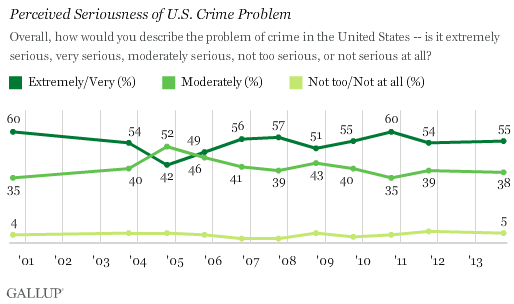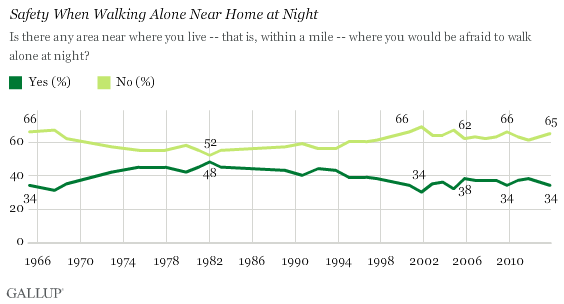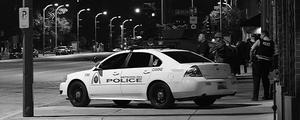WASHINGTON, D.C. -- A majority of Americans (55%) say crime is an extremely or very serious problem in the U.S. -- about the same level of concern they had in 2011, but down slightly from 2010. Another 38% view the U.S. crime problem as moderately serious, while one in 20 consider it not serious.

Americans see their local crime situation in almost the opposite way. A slim majority (51%) report that the crime problem is not too serious or not serious at all in the area where they live, up from 47% in 2011. This increase in optimism comes in the context of a rising national crime rate. About one in eight (13%) see the local crime problem as extremely or very serious, and 35% assess it as moderately serious.

Americans' likelihood to see crime as less of a problem in their local areas than nationally exemplifies a pattern in polling, whereby people tend to rate local situations better than national ones. This may help explain the virtual absence of crime in the national political discourse, even though majorities have generally rated the issue as an extremely or very serious problem in the U.S. since 2000. While many Americans appear to believe crime is a problem, it seems to be one that does not directly affect or threaten their lives.
Underscoring this point, Gallup's latest measure of the nation's Most Important Problem, from early October, found little mention of crime or violence as the nation's top problem. This is in line with the trend since the 2008 recession.
Majority of Americans Feel Safe in Their Neighborhoods
Relatedly, almost two-thirds of U.S. adults (65%) say they would not be afraid to walk alone at night in the area where they live, four percentage points higher than the 1965-2013 average. Thirty-four percent of Americans say they would be afraid to walk alone at night; down significantly from the 1970s to mid-1990s, when at least four in 10 were.

While the proportion of Americans saying they do not feel safe walking near their homes at night is on the lower end of Gallup's historical trend, some groups do feel especially vulnerable. Women (44%) are more likely than men (24%) to say they are afraid. This gender divide has been evident in previous surveys and in other developed countries.
Individuals on the poorer side of the income distribution are also more likely to be afraid to walk alone in their area at night -- including nearly half (48%) of those making less than $20,000 per year and 44% of those earning between $20,000 and $29,999. Those in the two upper-income brackets feel more secure than the overall population -- 31% of those earning $50,000 to $74,999 and a quarter of persons accruing $75,000 or more express such fear.
Implications
From the famous "Willie Horton" ad during the 1988 presidential campaign to President Bill Clinton's passing an anti-crime bill early in his presidency to the "tough on crime" approach of popular politicians like former New York Mayor Rudy Giuliani, crime has historically been a salient political issue at the national level. But judging from last year's presidential election that scantly mentioned crime in the various policy debates, this is no longer the case -- even as Gallup finds, for yet another year, a majority of Americans rating crime as an extremely or very serious problem for the nation. Crime has taken a back seat as monumental domestic concerns have flared up over the past decade -- terrorism, war, and an economic crash -- but another reason it hasn't received as much emphasis could be that the majority of Americans don't believe crime is a threat where they live, and feel safe in their neighborhoods.
Survey Methods
Results for this Gallup poll are based on telephone interviews conducted Oct. 3-6, 2013, on the Gallup Daily tracking survey, with a random sample of 1,028 adults, aged 18 and older, living in all 50 U.S. states and the District of Columbia.
For results based on the total sample of national adults, one can say with 95% confidence that the margin of sampling error is ±4 percentage points.
Interviews are conducted with respondents on landline telephones and cellular phones, with interviews conducted in Spanish for respondents who are primarily Spanish-speaking. Each sample of national adults includes a minimum quota of 50% cellphone respondents and 50% landline respondents, with additional minimum quotas by region. Landline and cell telephone numbers are selected using random-digit-dial methods. Landline respondents are chosen at random within each household on the basis of which member had the most recent birthday.
Samples are weighted to correct for unequal selection probability, nonresponse, and double coverage of landline and cell users in the two sampling frames. They are also weighted to match the national demographics of gender, age, race, Hispanic ethnicity, education, region, population density, and phone status (cellphone only/landline only/both, and cellphone mostly). Demographic weighting targets are based on the March 2012 Current Population Survey figures for the aged 18 and older U.S. population. Phone status targets are based on the July-December 2011 National Health Interview Survey. Population density targets are based on the 2010 census. All reported margins of sampling error include the computed design effects for weighting.
In addition to sampling error, question wording and practical difficulties in conducting surveys can introduce error or bias into the findings of public opinion polls.
View methodology, full question results, and trend data.
For more details on Gallup's polling methodology, visit www.gallup.com.
